JonathanJung
Member
- Joined
- Apr 7, 2018
- Messages
- 265
Float-mount a seat on a chair, or glue it down permanently?
I've been attaching the seats to my chairs similar to a tabletop, see picture. However, it's not as clean looking and the screws can't grab very much wood, because of the deep seat scoop. The main thing though is that it doesn't suck the seat down tight to the frame, as tight as I'd like. There is only 3/8 - 1/2" screw penetration so it's risky to really crank it down. Using the Wood Web shrinkage calculator, rift/qtr sawn walnut at 14" wide (the width of contact between seat and frame) has minimal movement, around 1/8". I'd rather be able to set a couple dominos and glue the seat down.
Does anyone know if glueing the seat down would be safe enough against splitting?
I've known breadboard ends on tabletops to not be an issue before. I realise that my customer's home humidity control will have an effect, so I calculated for an 8-12% MC variance.
I've been attaching the seats to my chairs similar to a tabletop, see picture. However, it's not as clean looking and the screws can't grab very much wood, because of the deep seat scoop. The main thing though is that it doesn't suck the seat down tight to the frame, as tight as I'd like. There is only 3/8 - 1/2" screw penetration so it's risky to really crank it down. Using the Wood Web shrinkage calculator, rift/qtr sawn walnut at 14" wide (the width of contact between seat and frame) has minimal movement, around 1/8". I'd rather be able to set a couple dominos and glue the seat down.
Does anyone know if glueing the seat down would be safe enough against splitting?
I've known breadboard ends on tabletops to not be an issue before. I realise that my customer's home humidity control will have an effect, so I calculated for an 8-12% MC variance.






